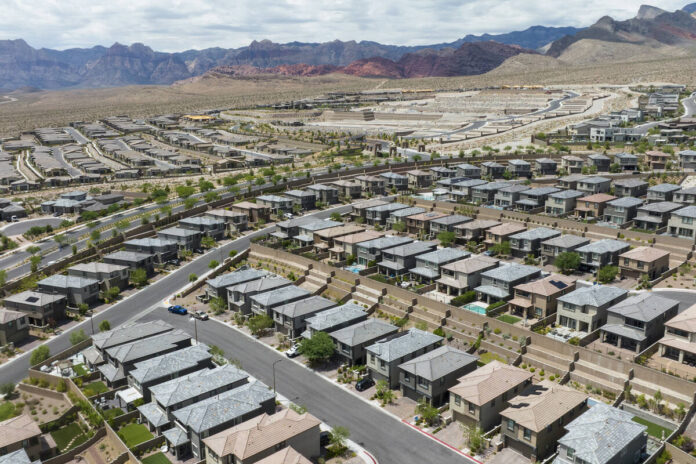The Las Vegas Valley’s real estate market has become a hot topic, with local realtors and major online brokerages at odds regarding whether it leans toward a buyer’s or seller’s market. This divide often stems from the intricate dynamics of the market, which can vary significantly from one neighborhood to another.
Forrest Barbee of Berkshire Hathaway Home Services notes the importance of looking at the market regionally. According to his analysis, the valley currently has about five months’ supply of homes, which denotes a balanced market. “Markets with three to six months of inventory are typically balanced,” he explains. In contrast, markets with over six months of inventory typically favor buyers, who can negotiate terms more aggressively.
Adding complexity to the discussion, Redfin revealed a stark shift in the market in August, indicating a buyer’s market characterized by a 96.7% oversupply of sellers compared to buyers. This shift has raised questions about the overall landscape of residential real estate in Las Vegas.
Real estate experts often rely on months of inventory when determining market conditions. In a buyer’s market, an abundance of homes slows sales, allowing buyers leverage in negotiations. Conversely, a seller’s market fosters competition among buyers, leading to quicker sales. Recent trends have shown that elevated mortgage rates and a significant number of homeowners locked into low rates from the pandemic have cast uncertainty over these indicators, complicating the picture as we head into 2025.
Neighborhood-specific data illustrates the contrasting conditions within the valley. For instance, MacDonald Highlands in Henderson, a luxury neighborhood, recorded an average of 127 days on the market with an impressive average sale price of $4.8 million. This area also boasts around eight months of inventory, indicating a sluggish pace. On the other end of the spectrum, Lone Mountain, a more affordable area, shows an average selling time of just 23 days, with homes averaging $673,224 and having nine months of inventory.
Barbee emphasizes the wild swings in the 2025 market, where downward pressure on median prices for single-family homes exists due to an uptick in sales within the lower-end market. This contrasts with an increase in luxury home offerings, which artificially inflates the average closed sale price. Such fluctuations make it difficult to predict the market’s trajectory.
Adding another layer of perception, Lori Galarza from Re/Max asserts that the market feels distinctly like a buyer’s market. “As of September, we have 7,502 homes listed for sale,” she states, noting that this figure seems substantial compared to previous years. While earlier in the year the market was considered transitional, many professionals now agree it leans more toward favoring buyers.
Galarza’s personal experience echoes a larger trend: listings are remaining on the market significantly longer. “I’m personally hosting more open houses to attract potential buyers,” she shares, pointing to the effectiveness of such strategies in the current environment. She also highlights that many potential buyers and sellers remain on the sidelines, hesitant due to favorable mortgage rates they currently enjoy.
George Kypreos, president of Las Vegas Realtors, offers an interesting perspective, suggesting the market is undergoing a reset characterized by an increase in homes for sale. “This is the most available inventory we’ve seen in some time, and we’re witnessing a more balanced market,” he explains. Kypreos concludes that numerous factors are shifting favorably for home buyers, particularly as we enter a season often regarded as the most opportune for purchasing.
Understanding Market Dynamics
To grasp the distinctions between a buyer’s and seller’s market, many turn to indicators like Zillow’s “Heat Index.” This tool assesses the balance of for-sale inventory and demand, ranking each market on a scale of 0 to 100. A score of 44 or less denotes a buyer’s market, whereas a score of 69 or higher indicates a seller’s market. Presently, the Las Vegas Valley represents a neutral zone, sitting at 50, suggesting a near balance in competition.
Orphe Divounguy, a senior economist at Zillow, observes that the market has remained largely neutral, with fluctuations primarily during the spring buying season. Active listings in September surged by 28% compared to the previous year, although the total still falls slightly below pre-pandemic levels. “In September, there were 13,033 active listings, just 3% away from pre-pandemic averages,” he remarks.
However, the dynamics are shifting again. Sellers are beginning to adapt to a more subdued market, with reports indicating fewer new listings and price cuts becoming increasingly common. Approximately 30% of current listings are experiencing price reductions, akin to levels seen in Austin but significantly higher than New York’s 16%.
This evolving landscape has left many wondering how the interplay of supply and demand will shape the Las Vegas Valley’s real estate future. Market participants, whether buyers or sellers, find themselves navigating a complex and shifting environment, with local nuances critical to informed decision-making.
For those keen on staying updated on the dynamic landscape of Las Vegas real estate, reaching out to industry professionals can provide invaluable insights and guidance.
